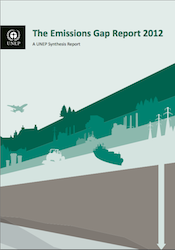There is a message that United Nations Environment Programme (UNEP) is delivering during the Doha Climate Change Conference taking place through December 7, 2012 in Qatar – despite efforts, carbon emissions are up 20 percent and greenhouse emission targets will not be met. The organization says if the world does not scale up and accelerate action on climate change immediately, emissions could rise to 58 gigatonnes (Gt) by 2020. This is far above the level some climate researchers say is safe to keep the global temperature from rising more than 2 degrees Celsius this century.
 UNEP has released its third Emissions Gap Report 2012 to coincide with the Climate Conference. The report concludes that if the world stays on a business-as-usual trajectory, more drastic and expensive cuts will be needed after 2020. Climate scientists have set a 2 degree target – meaning that if global temperature rising higher than 2 degrees, Earth as we know it will considerably change. Previous assessment report have underlined scenarios that provide options with costs as low as possible but early action was needed in these situations.
UNEP has released its third Emissions Gap Report 2012 to coincide with the Climate Conference. The report concludes that if the world stays on a business-as-usual trajectory, more drastic and expensive cuts will be needed after 2020. Climate scientists have set a 2 degree target – meaning that if global temperature rising higher than 2 degrees, Earth as we know it will considerably change. Previous assessment report have underlined scenarios that provide options with costs as low as possible but early action was needed in these situations.
Emissions of warming gases like carbon dioxide (CO2) are actually increasing, according to the report. Total greenhouse gas emissions have risen from around 40 Gt in 2000 to an estimated 50.1 Gt in 2010. The report states that even if the most ambitious level of pledges and commitments were implemented by all countries, and under the strictest set of rules, there would be a gap of 8 Gt of CO2 equivalent by 2020, 2 Gt higher than last year’s assessment.
With continued delayed action, the economic costs will skyrocket and the options narrow and become more severe. The report states that in this scenario, a heavier long-term dependence on mitigation technologies such as bioenergy and carbon capture and storage would occur.
Achim Steiner, UN Under-Secretary General and UNEP Executive Director, said: “There are two realities encapsulated in this report-that bridging the gap remains do-able with existing technologies and policies; that there are many inspiring actions taking place at the national level on energy efficiency in buildings, investing in forests to avoid emissions linked with deforestation and new vehicle emissions standards alongside a remarkable growth in investment in new renewable energies worldwide, which in 2011 totaled close to US$260 billion.”

